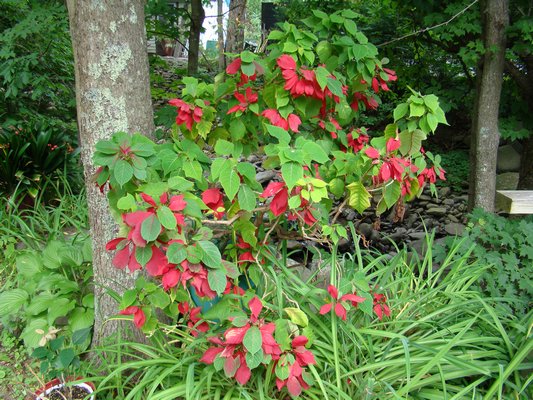

As I was visiting garden centers from Albany to East Hampton, I loved seeing what the talented staffs had set up for holiday displays. The range of holiday plants in so many colors, sizes and arrangements certainly conveyed the colors of the season and in some cases even the spirit. But blue poinsettias?I’d never seen these obnoxious creatures until I saw them in a supermarket in Boiceville, New York, but I’ve since learned that they’ve been around for three or four years. Are they real? Well yes, they are real plants, but like the blue orchids that showed up two years ago they are not a creation of nature, but simply ordinary poinsettias whose foliage has been sprayed with a blue vegetable dye. So, just like the fake blue orchids, these fake blue points won’t ever bloom blue again. Sorry. Not.
But what of the other millions of naturally deep-red, pink, white and other poinsettias? Will they ever bloom again and can you make them color up again next year for the holidays? At best, the answer is maybe. But there are some of us who just can’t trash a live plant until it’s dropped its last leaf, and for those who want to test their green thumbs instead of just spending another $5.99 next December, here are some tips.
Once home, the plant will thrive in indirect, natural daylight for a minimum of six hours a day. Avoid any location where the plant is exposed to direct sunlight as this may fade the bract (“flower”) color. To prolong the bright colors of the plants, try to keep the daytime temperature below 70 degrees and keep the plant away from dry air that comes from heating vents, appliances and fireplaces.
The soil should be moderately moist, but never dripping wet. This is usually accomplished by watering thoroughly when the soil surface feels dry to the touch. Remove the plant from decorative pots and covers to make sure that there’s adequate drainage and then water to thoroughly saturate the soil. Do not allow the plant to sit in standing water, as this usually results in root rot. If the plant is in a saucer and water accumulates in it after watering, empty the saucer. Feeding is not necessary while the plant is in “bloom,” but after the holidays a balanced fertilizer such as 10-10-10 or 20-20-20 should be applied regularly, only at about half the label’s recommended rate.
The plants can go outdoors in early May (remember, no direct sunlight!) and should be repotted into a larger pot in June using a peat-lite soil like Pro-Mix. Reblooming is not a trick, but remember that the plant is photoperiodic, setting buds and producing bracts in the fall as nights become longer.
At the first sign of whiteflies, trash the plant. There’s really never just one, so if you spot an isolated whitefly, usually on the underside of the foliage, you can be sure there are more to come. It’s not worth the bother to try to control them and if not quickly eradicated, which is nearly impossible at home, they will spread rapidly to other plants. If the whiteflies do appear, put a plastic bag over the plant before moving it. This contains them during the trashing process.
The plants can go outdoors during the summer with the precautions noted. Careful with the sun, watch for bugs and keep the plant evenly watered. The poinsettia can tolerate cold but it won’t put up with frost or freezing, so it should be brought indoors with any other tender plants, shortly after Labor Day.
Now it’s time to start the process that brings back the color. Keep in mind that the colors that we see on these plants are not flowers but flower bracts that surround the flower clusters. The actual flowers are about the size of a pea and relatively inconspicuous. So it’s confusing when we refer to poinsettias in flower when what we are actually seeing is colorful leaf adaptations.
To time reblooming precisely, the plant needs 14 hours of continuous darkness each night beginning October 1 and continuing for 8 to 10 weeks. The darkness part is a bit tricky though, because any extraneous sources of light, even a streetlight or night light, will have an effect on when the colors reappear. Growers will often use a blackout cloth over the plants at night to ensure the precise timing they need to have the plants in full color and ready for sale in December. And nighttime temperatures should not drop below 60 degrees. Less precise timing or excess light will result in less precise blooming, but color should reappear next year, rewarding any or all of your efforts.
One hint, though. If you have the space for the plant in a dark closet and if you follow the strict 14-hour schedule, you can put the plant in the closet every night. As long as no light is leaking in, your efforts will reward you with on-time color.
Reflowering takes perseverance for success, and remember that if at first you don’t succeed, there’s always next year. Have a very happy holiday season, and I’ll be back in two weeks to start the gardening cycle all over again. Keep growing.
 More Posts from Andrew Messinger
More Posts from Andrew Messinger